Vera Olkhovskaya
The processing (hem) of the bottom of the product proposed in this article is suitable for many types of light ladies' clothing.
As you can see in the pictures, this is a machine way to sew a blind stitch.
Processing the bottom with an open cut.
This means that the cut will remain visible from the wrong side of the product.
So, the hemmed section is pre-overcast on the overlock (see also Machine seams. How to replace stitching and overlock ").
Overcasting is only necessary if the fabric is loose.
The cut can be left unswept if strong shedding does not threaten (Fig. 1 a).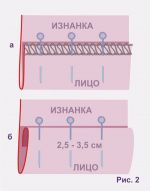
Then the cut is bent to the wrong side by 2,5 - 3 cm, stabbed with sewing pins and ironed (Fig. 2 a).
In this case, it is better to use pins with wire heads in the form of a loop, since pins with a plastic ball will interfere with ironing the cut and laying the machine stitch.
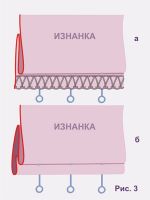 The next stage: the folded inside out and ironed section is folded over to the face of the product, so that the wrong side of the overlock line is visible.
The next stage: the folded inside out and ironed section is folded over to the face of the product, so that the wrong side of the overlock line is visible.
This is shown in fig. 3 a.
Finally, we lay a zigzag stitch right along the overlock.
As you can see, the hidden stitch in this case is able to take on an additional function - to protect the open section of the fabric from shedding, therefore, an overlock (overlock stitch) is not necessary here.
In other words, preliminary overcasting is needed only in extreme cases - to strengthen sections of very loose fabrics.
Finishing the bottom with a closed cut
Another type of bottom processing is with a closed cut. In this case, the cut is between the layers of fabric and is not visible even from the inside of the product.
To begin with, the processed section should be folded inside out and ironed (Fig. 1 b), while the hem width is 1 cm.
Then bend the fabric a second time to the wrong side and the width of the hem at this stage is 2,5 - 3,5 cm.
The second hem is fixed with tailor's pins with a wire eye or swept up and ironed again (Fig. 2 b).
The ironed allowance is folded towards the “face” of the product, as shown in Fig. 3 b.
And we complete the processing with the actual hidden line (Fig. 4 b).
Which way to choose - with an open cut or with a closed one?
As a rule, in a hem with open cut process skirts, pants (classic trousers - with trouser tape - see photo) "Pants Handling"), Dresses, jackets - all products of their woolen and costume assortment.
This applies to both light dresses and outerwear.
In outerwear on a detachable lining, the bottom of the "top" is processed with a seam open cut, and the lining itself - closed cut.
An example is ladies coat or women's coat (trench coat).
And, if this product has an extended silhouette - a trapezoid, a flared lower part (in cutoffs at the waist, this is a skirt) - then the lining is hemmed not with a hidden stitch, but with one of the zigzag stitches.
Patterns of women's coats
Women's coats Fur coats Jackets Capes
In products with "closed th "lining - men's and women's jackets or jackets - the bottom is processed into a hem with an open cut, which is not pre-overed.
th "lining - men's and women's jackets or jackets - the bottom is processed into a hem with an open cut, which is not pre-overed.
Jacket patterns
|
||||||||||||
And one more - an industrial method of processing the bottom with a closed cut - hemming with a special device (see photo).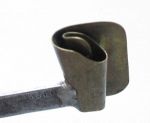
The product is located inside out, the edge of the fabric is tucked into the folded part of the fixture and a straight machine stitch is laid along the folded edge.
This processing option is suitable for sheets, handkerchiefs, neckerchiefs, bathrobes and a light dress made of cotton and silk fabric.
The bottom is also hemmed in jeans.
But for each type of product, you need to have a separate fixture for a specific hem width and for a specific fabric width.
If necessary, such a device can be purchased at specialized sewing stores.
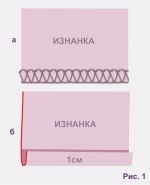







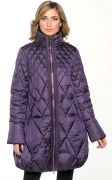









 Join my community on Viber...
Join my community on Viber...











